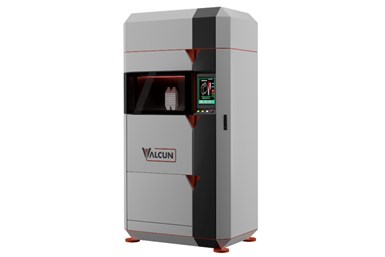ValCUN’s Minerva Printer Offers Easy-to-Use, Sustainable Metal Additive Manufacturing
Formnext 2023: ValCUN’s Minerva Printer for metal additive manufacturing enables metal to be deposited in a single-step process, using off-the-shelf metal as feedstock.
Valcun’s Minerva Printer for metal additive manufacturing (AM) is designed to offer unmatched deployability, sustainability and cost-effective metal printing utilizing ValCUN’s proprietary Molten Metal Deposition (MMD) technology.
The MMD technology is inspired by fused filament fabrication (FFF), enabling metal to be deposited in a single-step process, using off-the-shelf metal as feedstock. MMD reduces lead times and provides on-demand manufacturing. The company says this sustainable technology is energy efficient, environmentally friendly and eliminates the need for toxic chemicals or metal powders.
The printer offers aluminum 3D printing in a deployable, compact and sustainable way. It comes with an open parameter set, open materials, open data acquisition and open nozzle architecture, giving users the freedom to tweak parameters for their needs.
The Minerva printhead enhances the user’s flexibility and freedom to operate. The printhead can be implemented on robotic arms, gantry systems and in production facilities or inline with other fabrication technologies. The MMD technology can easily be integrated into users’ existing machines. The printhead can be set up on a robotic arm, enabling users to create their own versatile metal 3D printing. Or users can create hybrid AM by installing ValCUNs’ printhead into a milling center. For research, the printhead can also be used as a droplet generator.
MMD achieves single-step metal deposition, akin to Fused Filament Fabrication (FFF) but with metals. This well-known process employs readily available off-the-shelf metal wire as feedstock, ensuring user-friendly operation and rapid implementation. The Minerva printer and the Minerva printhead are currently focusing on Aluminum, a highly sought-after metal by industry that is currently underserved by existing AM processes. The nature of the process also enables printing of high-strength aluminum allots, such as 6XXX series and 7XXX series.
MMD is said to offer unmatched sustainability, with its energy efficiency, reduced waste and elimination of the need for toxic chemicals or powders. Because of its straightforward postprocessing (no need for debinding, sintering, powder removal or HIP), MMD also offers exceptional time-to-part.
Related Content
-
GE Additive Helps Build Large Metal 3D Printed Aerospace Part
The research is part of an initiative to develop more fuel-efficient air transport technologies as well as a strong, globally competitive aeronautical industry supply chain in Europe.
-
3D Printing Brings Sustainability, Accessibility to Glass Manufacturing
Australian startup Maple Glass Printing has developed a process for extruding glass into artwork, lab implements and architectural elements. Along the way, the company has also found more efficient ways of recycling this material.
-
Alquist 3D Looks Toward a Carbon-Sequestering Future with 3D Printed Infrastructure
The Colorado startup aims to reduce the carbon footprint of new buildings, homes and city infrastructure with robotic 3D printing and a specialized geopolymer material.
















